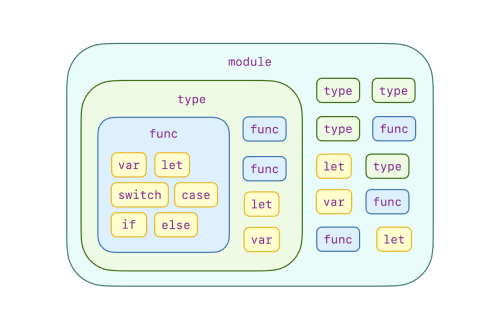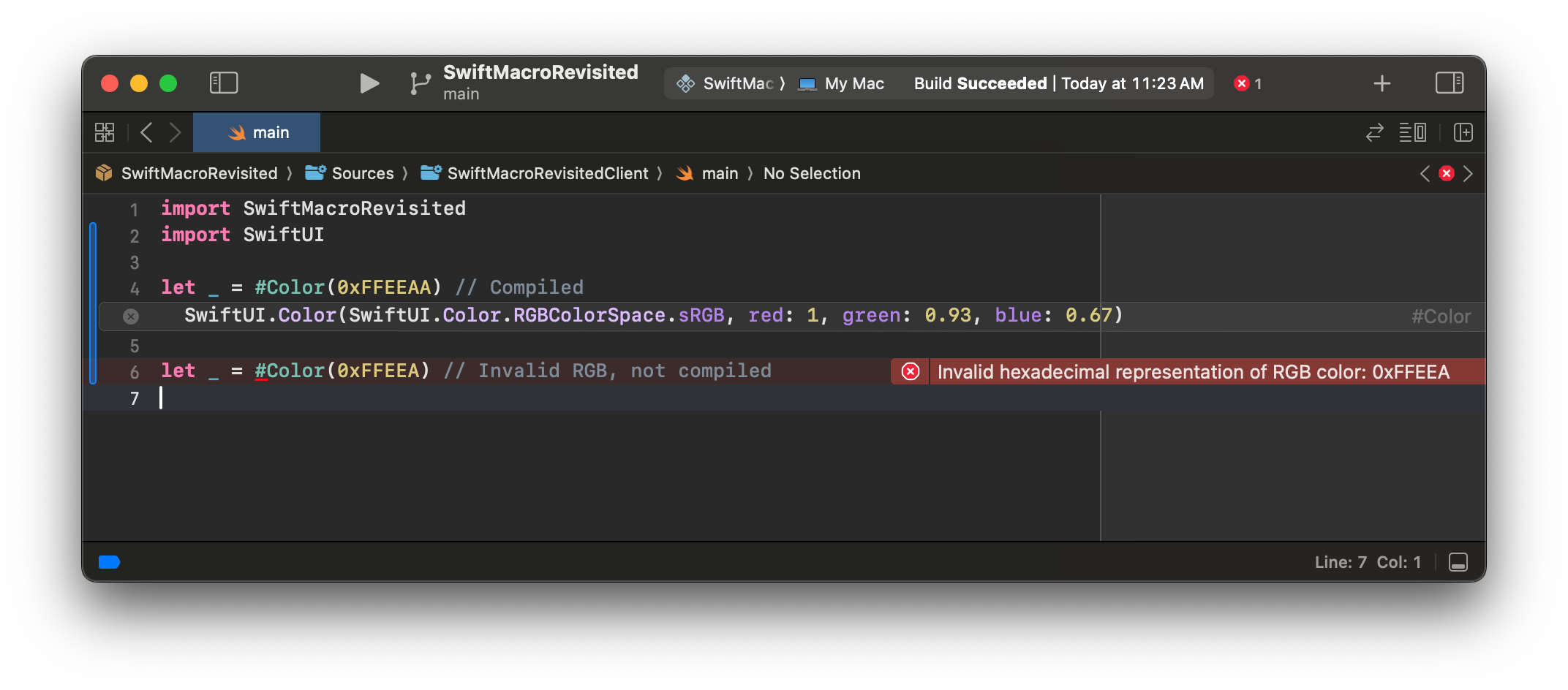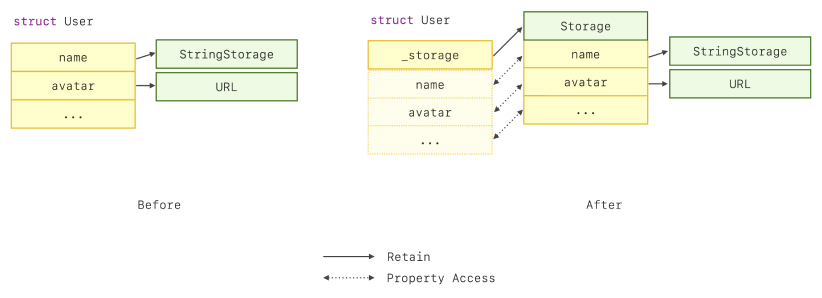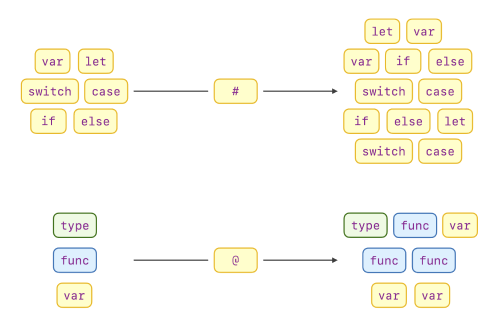Swift Macro: Revisited - The Strengths and Essence
From the sessions at WWDC 2023, we learned that Swift Macro aims to:
- Eliminate boilerplates
- Make tedious things easy
- Share with other developers in packages
However, these goals aren't unique to Swift Macro. They are common objectives for many code reuse methods in Swift, such as functions, types, and modules. One could argue that all high-level programming languages aspire to these ends. There must be something else that Swift Macro excels at; otherwise, it would be redundant.
So, what is it that Swift Macro does exceptionally well?
The answer to this question is crucial. The unique strengths of Swift Macro defined its essence. It can guide us in crafting Swift macros that are effective, inform us of the boundaries when creating them, and ultimately lead us to produce well-designed Swift macros.
To grasp this, we need to first comprehend the problems that existing code reuse methods in Swift have managed to solve and their limitations. The key to understanding what sets Swift Macro apart lies in this exploration.
What Existing Code Reuse Methods Managed To Solve?
In Swift, the methods for code reuse encapsulate the code at various levels of granularity, from the finest functions to the coarsest modules. This design offers a hierarchical toolset to help us eliminate boilerplates in our code at each level.
However, a well-designed code reuse method not only means to eliminate unnecessary copy-and-pastes but also brings order to chaos. From the high-level programming language developer's perspective, the chaos usually comes from unexpected lookup results for the names of variables, functions or types and unexpected execution order of the program.
More than that, real-world code reuse stories often involve codes provided by various parties. This means for the compiled programming languages the code to reuse might be in variant distribution forms: either the source code or prebuilt libraries.
Let's explore how existing Swift code reuse methods handle all these well.
Functions
Swift functions are the finest code reuse method in Swift. Programmers
encapsulate basic algorithms by organizing sequences of execution flows
with control structures such as if ... else ... statement, while loop,
for loop and return statement. Variables declared within the block of
a control structure have higher lookup priority than those declared
outside. There is a piece of code that illustrates an example of this.
Each line represents a name lookup result.
swift
This scene has become familiar in our daily programming. However, this didn't come easy. The idea behind this design is called structured programming, defined by several key principles:
- Variables are only accessible within the block of a control structure.
- Control structures could be more expressive like using
if ... else ...instead of a simpleifstatement. - The goto statement could be eliminated by more advanced control structures.
- The function could be defined within other functions.
The very first high-level programming language FORTRAN did not incorporate these principles as we understand them today. It took the industry several years to develop and integrate these concepts fully. The idea then significantly influenced the design and evolution of high-level programming languages after its introduction. Swift also embraced this idea to enable programmers to build robust functions.
Types
Swift types allow programmers to aggregate data and functions that share internal relationships. This enables code reuse in a greater level of granularity which is compared to standalone functions.
However, simply packing a bunch of things into one does not eliminate the complexity. When accessing members declared in a type, there should be principles similar to the access rules for variables in structured programming. Such that we can ensure expected name lookup results. Or there could be endless name collisions across types.
Yet, the internal data and the implementations should not be accessible outside a particular scope, such as the type or the source file, etc. This could decrease the mind burden for the programmers that use the type by exposing only necessary information to the programmers, preventing undefined behaviors caused by unexpected access to the internal implementations and defining a limited scope that the type can collaborate.
Swift types overcome the aforementioned challenges by:
- Type members such as variables and functions declared can be accessed within the block of the type definition.
- Introducing the dot-notation syntax to access members outside the type block.
- Introducing access control to protect members in a type within a particular scope.
swift
With all these points, programmers can intuitively expect the name lookup results when working with types by generalizing what they learned from Swift functions that adopted principles of structured programming and bringing the experience got in other languages that have dot-notation syntax and access control.
Modules
From the previous section, we saw how Swift enhances code reusability with types when data and functions share internal relationships. How can we further improve reusability when types also share these relationships?
An intuitive answer is to further encapsulate types, data and functions into an abstract at a greater granular level. In Swift, it is what the module does.
However, in Swift, the module is not simply yet another aggregation of code. Just like the type system, a naïvely designed module system may also introduce name collisions across modules and expose unnecessary implementation details. Swift avoids this by continually generalizing what we learned from how Swift avoids similar problems in types:
- Module members such as variables, functions and types can be accessed within the module.
- Introducing the dot-notation syntax to access members outside the module when there are names in different modules collide.
- Introducing access control to protect members in a module within a particular scope.
swift
On top of that, the module is also a way to distribute your code. Since people may distribute their code either in source code or prebuilt binary, the Swift compiler may consider this while implementing the module system.
Recap
By examining the existing code reuse methods in Swift, we can find they tend to aggregate smaller abstractions into greater ones with a particular protective mechanism to ensure reasonable name lookup results and expected program execution flow.
However, what gives them advantages also caps their capabilities. Due to those protective mechanisms, there are still programming concepts that cannot be encapsulated -- because some concepts require us to drop this protection.
To further improve the code reusability of the language, we no longer can follow the established trends of these existing code reuse methods.
What Swift Macros Do Exceptionally Well?
Conversely, Swift Macro improved the code reusability of the language by embracing different design philosophies. To help you build a comprehensive understanding of these design philosophies, I would like to show you the nature of Swift Macro with some typical examples.
Compile-Time Translations and Verifications
Design software like Figma and Sketch represent the RGB color with 6 hexadecimal digits. Developers often extend the type of color to allow direct copying and pasting of RGB values from design software for use in Swift:
swift
But how do we verify that the pasted value is a valid RGB color? The action of copy-and-paste does not ensure the correctness of the result. The following code snippet shows a potential mistake that results in a copy-and-paste.
swift
However, because Swift macros syntactically transform their arguments to generate new code, or say "to expand the macro", we can integrate syntax checking during this transformation. This enables compile-time verification for 6-digit hexadecimal RGB color "literals".
swift
From this example, you may be inspired to see how this compile-time computability can be applied to other types of "literals".
Offering Behaviors Beyond The Functions
In practice, we typically aim to avoid using an exclamation mark to forcefully unwrap optional values:
swift
Instead, we prefer a safer approach -- use guard let ... else:
swift
However, this can be cumbersome, especially with multiple optional parameters.
Given a programmer's nature, there must be a desire to encapsulate this
unwrapping process for reuse. Unfortunately, since a function protects its
internal execution flow from inner functions' return
for the sake of structured programming, we cannot encapsulate this
guard let ... else in a function -- because the return statement in a
function cannot make the caller site function exit.
swift
However, Swift Macro provides a feasible method for this type of
encapsulation. We can have a macro called #unwrap which has the
following use example:
swift
This could be expanded as:
swift
In the example above, the arguments of the #unwrap macro -- bar and
the trailing closure, are type-checked before the compiler initiates the
macro expansion process. This means the bar received by print in the
trailing closure would be bound to the parameter _ bar: Int? of the
foo function after the type-check.
However, once the macro expanded, since the expansion process itself could
be seen as a syntax replacement much like the copy-and-paste, the bar
used by print now is bound to the one declared by the guard let bar
statement, being unrelated to the type-check result before the macro
expansion. More than that, the return statement brought by this macro
expansion can also affect the control flow of the applied site now.
This example shows the evidence that the expansion of a freestanding Swift macro could involve control flow manipulation and lexical scope sharing.
Offering Behaviors Beyond Types
The capabilities of Swift Macro are not bound to these boundaries. Let's consider another kind of Swift Macro: attached macros and showcase its potential with a real-life example.
In real-world programming, we often start with types with simple definitions. Here is an example:
swift
However, as the repository grows, the structs might expand
proportionally:
swift
Since each property in the struct of this example requires heap
allocation for data storage, the cost of copying this struct also rises.
The number of heap allocations corresponds to the number of retaining
operations during the copy. Since retaining is atomic, this could
potentially cause lagging in user interactions and waste in memory space.
To minimize the struct's copying cost, we can adopt copy-on-write behavior to the original struct by aggregating the properties into a class instance that acts as the storage and copying the storage when altering the properties:
swift
To understand this technique further, there is an illustration shows the difference between the working details before and after adopting the copy-on-write behavior:
This is a useful technique to improve the performance when copying big
structs comes to be the bottleneck. In real-world testing, I improved
the performance of an app produced by ByteDance by adopting this
technique, increasing the FPS of a particular scene from 48 to 56 and
reducing the debug-time overall memory usage by 600MB.
However, the approach I showed above can be cumbersome. It not only involves a lot of hand-roll code but, worse still, it increases the cost of maintaining the program.
More than that, this technique cannot be encapsulated with any existing
kind of types in Swift: no matter class, struct, enum or protocol.
This is because what I've done to the struct is to extend the type's
behaviors by transforming the existing members into another form. Since we
can only reuse a type with aggregation, inheritance and conformance, none
of this could help us encapsulate this piece of logic.
But Swift Macro offers what we want. We can encapsulate this code transformation process with Swift Macro and approach what I've done in the previous example more elegantly.
swift
Yes. Just as simple as I've shown. By adding an attached macro called
@COW to the struct, we have introduced the copy-on-write behavior to
this struct.
What this macro did is nothing more than what we have hand-rolled in the previous example -- adding heap storage to the struct and transforming the stored properties into computed properties that forward access to the heap storage:
swift
However, all these above happen in an automatic process that the Swift
compiler type-checks the User struct and then invokes the macro
expansion by using the type-checked User struct as an argument. Finally,
the @COW macro generates code by understanding the contents in the
User struct. With this automatic mechanism, the cost of maintenance has
been eliminated.
From the macro expansion shown above, it can be observed that attached Swift macros can extend types with members and rewrite properties by adding accessors. The extended contents not only bring new behaviors to the type but also share the "namespace" of the extended point. It is also worth noting that adding accessors to a stored property also changed its semantics from a stored property into a computed property.
Conclusion
By studying the existing code reuse methods in Swift and understanding the characteristics of the newer Swift macros, we can draw the following conclusions:
- Swift Macro is yet another form of encapsulation. It does not bring any new runtime capabilities.
- Swift Macro generates codes by transforming the programmer's code at the compile time. This means that we can also integrate compile-time verification into it.
- Unlike existing code reuse features in Swift, Swift Macro does not protect its expansion from the existing contents of the applied site by default. Yet, it also can change the semantics of applied site. Macro authors shall watch out for potential traps and pitfalls while implementing Swift macros. To be specific:
- For freestanding Swift macros, they can affect the control flow of the applied site as well as share the lexical scope.
- For attached Swift macros, they can extend members to types as well as accessors to properties. The extended contents also share the same "namespace" of the extended point. More than that, accessor macros could turn a stored property into a computed property by adding either the
get,setor other undocumented accessors like_read,_modify,unsafeAddressandunsafeMutableAddress.
These properties offer programmers not only another option for code reuse but also the ability to encapsulate programming concepts that involve compile-time checking, control flow manipulations, and adding behaviors to types without relying on inheritance or other runtime techniques. These properties have never been implemented in Swift before. Without a doubt, they are the unique strengths that define Swift Macro.
However, the same features that give Swift Macro its advantages also introduce potential traps and pitfalls. We will delve into this topic in the following post.
Resources
A playground project that implements the
#Colorand#unwrapmacro (needsgit checkout strengths-and-essence)The production level implementation of the
@COWmacro:




